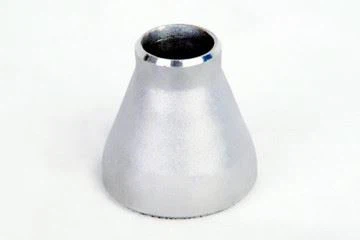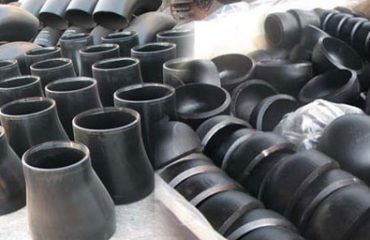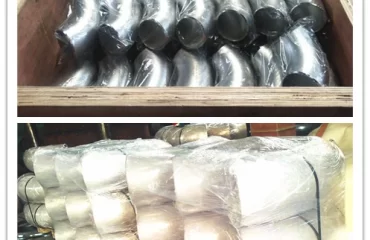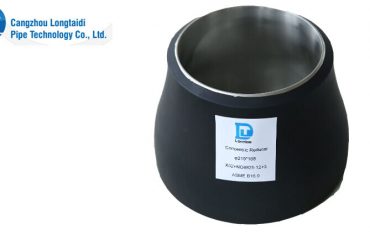
Pembedahan Mendalam Gred Tertentu
WP304 dan WP304H
WP304: Gred ini adalah keluli tahan karat yang paling banyak digunakan, terkenal dengan kepelbagaian dan keseimbangan sifatnya. Ia menawarkan ketahanan yang sangat baik terhadap kakisan dalam persekitaran atmosfera dan banyak media menghakis. Sifat mekanikal yang baik dan kebolehbentukan menjadikannya sesuai untuk pelbagai aplikasi, from kitchen equipment to chemical processing.
WP304H: The high-carbon version of WP304, WP304H is designed for high-temperature applications. The increased carbon content enhances its strength at temperatures above 500°C (932° F). Common applications include boiler and heat exchanger components.
WP309
WP309 stainless steel contains higher levels of chromium and nickel compared to WP304, providing superior oxidation resistance. This grade is often used in environments where high temperatures and corrosive conditions coexist, such as furnace parts, thermal oxidizers, dan penukar haba.
WP310
WP310 is another high-temperature resistant grade, with even higher chromium and nickel content than WP309. It maintains excellent resistance to oxidation and corrosion in environments up to 1100°C (2012° F). Typical applications include furnace components, heat treatment baskets, and chemical processing equipment.
WP316 dan WP316L
WP316: The inclusion of molybdenum in WP316 enhances its resistance to chloride pitting and crevice corrosion, making it ideal for marine and chemical environments. It is commonly used in pharmaceutical and food processing equipment, as well as in coastal architectural applications.
WP316L: The low-carbon variant of WP316 offers improved weldability and reduced risk of carbide precipitation during welding. This makes it a preferred choice for welded applications in harsh environments, such as chemical tanks and pipeline systems.
WP317L
WP317L stainless steel contains higher molybdenum content than WP316, providing even better resistance to pitting and crevice corrosion. It is used in highly corrosive environments such as chemical processing, petrokimia, and pharmaceutical industries.
WP321
WP321 is stabilized with titanium, yang menghalang pembentukan karbida kromium pada suhu tinggi, dengan itu meningkatkan ketahanannya terhadap kakisan intergranular. Ia sesuai untuk aplikasi yang melibatkan pemanasan berterusan dan sekejap, seperti manifold ekzos dan komponen aeroangkasa.
WP347
Sama dengan WP321, WP347 stabil, Tetapi dengan Columbium (Niobium). Gred ini menawarkan ketahanan yang sangat baik terhadap kakisan intergranular dan biasanya digunakan dalam pemprosesan kimia suhu tinggi dan aplikasi penjanaan kuasa.
WP904L
WP904L adalah keluli tahan karat austenit aloi tinggi dengan rintangan kakisan yang luar biasa, terutamanya terhadap persekitaran asid sulfurik dan klorida. Kandungan nikel dan molibdenum yang tinggi, bersama -sama dengan penambahan tembaga, Tingkatkan ketahanannya terhadap kakisan pitting dan celah. Aplikasi biasa termasuk peranti penyejukan air laut, pemprosesan kimia, dan komponen kilang minyak.
Senario penggunaan terperinci
pemprosesan kimia
Dalam industri kimia, Rintangan terhadap pelbagai asid dan klorida adalah penting. Gred seperti WP316, WP316L, WP317L, dan WP904L lebih disukai untuk rintangan kakisan mereka. Bahan ini digunakan dalam reaktor, tangki simpanan, dan sistem paip di mana pendedahan kepada bahan kimia yang keras adalah perkara biasa.
Industri minyak dan gas
Sektor minyak dan gas menuntut bahan yang dapat menahan tekanan yang tinggi, suhu, dan persekitaran yang menghakis. WP304H, WP309, WP310, dan WP347 sering digunakan dalam industri ini. Mereka terdapat dalam aplikasi seperti komponen penapisan, Saluran paip, dan peralatan penggerudian luar pesisir.
Aplikasi Marin
Persekitaran marin sangat mengakis, terutamanya kerana kehadiran klorida. WP316, WP316L, dan WP904L sangat sesuai untuk keadaan sedemikian. Mereka digunakan dalam pembinaan kapal, Struktur Luar Pesisir, dan tumbuhan penyahgaraman.
penjanaan kuasa
Tumbuhan kuasa memerlukan bahan yang dapat menahan suhu dan tekanan yang tinggi. WP321 dan WP347 sangat sesuai untuk aplikasi ini kerana kestabilan dan ketahanan mereka terhadap kakisan intergranular. Ia digunakan dalam komponen dandang, Penukar Haba, dan bahagian turbin.
Industri Makanan dan Minuman
Sanitasi dan rintangan kakisan adalah yang paling penting dalam industri makanan dan minuman. WP304 dan WP316 biasanya digunakan kerana tidak reaktiviti mereka dengan bahan makanan dan kemudahan pembersihan. Aplikasi termasuk peralatan pemprosesan makanan, tangki simpanan, dan paip.
Ringkasan
Pengurangan keluli tahan karat yang mematuhi gred ASTM A403 WP menawarkan pelbagai sifat yang disesuaikan dengan keperluan perindustrian tertentu. Pemilihan gred yang sesuai bergantung kepada faktor -faktor seperti rintangan kakisan, Ketahanan Suhu, Sifat Mekanikal, dan kebolehkimpalan. Memahami faedah dan aplikasi unik setiap gred memastikan prestasi optimum dan panjang umur sistem paip di pelbagai industri.
Rujukan
- ASTM A403/A403M: Spesifikasi Standard untuk Kelengkapan Paip Keluli Tahan Karat Austenitik Tempa.
- ASM Antarabangsa: Buku Panduan Keluli Tahan Karat.
- NACE Antarabangsa: Asas Kakisan: Satu Pengenalan.
- Kesusasteraan Teknikal: Sifat bahan dan proses pembuatan untuk pengurang keluli tahan karat.
- Laporan Pasaran: Trend dan ramalan untuk industri keluli tahan karat.
Dokumen yang komprehensif ini harus memberikan pemahaman yang mendalam tentang pengurangan keluli tahan karat dalam gred ASTM A403 WP, membimbing pemilihan dan penggunaan bahan -bahan ini dalam pelbagai konteks perindustrian.
Proses pembuatan terperinci
Untuk memahami sepenuhnya keupayaan dan batasan ASTM A403 WP Reducers Stainless Steel, Adalah penting untuk menyelidiki proses pembuatan yang terlibat. Proses ini sangat mempengaruhi sifat mekanikal, Struktur mikro, dan secara keseluruhan kualiti produk akhir.
pengkelasan
pengkelasan adalah kaedah biasa yang digunakan untuk mengeluarkan pengurangan keluli tahan karat. Proses ini melibatkan pemanasan keluli ke suhu tinggi dan kemudian membentuknya menggunakan daya mampatan. Menambah meningkatkan struktur bijirin, mengakibatkan sifat mekanikal yang dipertingkatkan, termasuk kekuatan dan ketangguhan.
- Terbuka Terbuka: Involves deforming the metal between multiple dies that do not completely enclose the material. It’s suitable for large, custom shapes.
- Closed-Die Forging: Utilizes dies that fully enclose the material, allowing for precise and consistent shapes. This method is ideal for high-volume production of smaller reducers.
Pemesinan
Pemesinan is often employed to achieve the final dimensions and tolerances required for stainless steel reducers. This process involves removing material from a workpiece using cutting tools.
- Turning: Used to create cylindrical parts by rotating the workpiece against a cutting tool.
- Milling: Involves using a rotating cutting tool to remove material and create flat or complex surfaces.
- Drilling and Tapping: Essential for creating holes and threads in the reducers.
rawatan haba
rawatan haba processes are crucial in enhancing the mechanical properties and corrosion resistance of stainless steel reducers. Common heat treatment methods include:
- Penyepuhlindapan: Involves heating the steel to a specific temperature and then slowly cooling it. This process relieves internal stresses, improves ductility, and refines the microstructure.
- Penyepuhlindapan Penyelesaian: Specific to austenitic stainless steels, this process dissolves precipitated carbides, meningkatkan rintangan kakisan.
Welding
Welding is often required to join stainless steel reducers to other components in a piping system. The welding process must be carefully controlled to prevent issues such as carbide precipitation, which can compromise corrosion resistance.
- TIG (Gas Lengai Tungsten) Welding: Offers precise control and high-kualiti welds, making it suitable for thin sections and critical applications.
- SAYA (Gas Lengai Logam) Welding: Provides faster welding speeds and is suitable for thicker sections.
Kemasan Permukaan
Kemasan Permukaan processes are essential for improving the appearance, Rintangan kakisan, and cleanliness of stainless steel reducers.
- Penjerukan dan Pasif: Involves removing surface contaminants and oxide scales, followed by passivation to restore the protective chromium oxide layer.
- Electropolishing: An electrochemical process that smooths and polishes the surface, enhancing its corrosion resistance and reducing the risk of contamination.
Kawalan dan Pengujian Kualiti
Ensuring the kualiti and performance of stainless steel reducers is paramount. Various testing and quality control measures are implemented throughout the manufacturing process.
Analisis kimia
Analisis kimia verifies the composition of the stainless steel, ensuring it meets the specified grade requirements. Techniques such as Optical Emission Spectroscopy (OES) and X-ray Fluorescence (XRF) biasa digunakan.
Ujian Mekanikal
Ujian Mekanikal assesses the strength, kemuluran, and toughness of the material. Ujian biasa termasuk:
- Ujian Tegangan: Measures the material’s response to tensile forces, providing data on yield strength, Kekuatan Tegangan, dan pemanjangan.
- Ujian Kekerasan: Determines the material’s resistance to indentation and wear.
- Ujian Kesan: Evaluates the material’s toughness, particularly at low temperatures.
Ujian Tidak Memusnahkan (NDT)
Ujian Tidak Memusnahkan methods are used to detect surface and subsurface defects without damaging the material. Kaedah NDT biasa termasuk:
- Ujian Ultrasonik (OUT): Menggunakan gelombang bunyi frekuensi tinggi untuk mengesan kecacatan dalaman.
- Ujian Radiografi (RT): Employs X-rays or gamma rays to reveal internal defects.
- pewarna ujian penusukan (DPT): Used for detecting surface cracks and defects.
Pemeriksaan Dimensi
Pemeriksaan Dimensi ensures that the reducers meet the specified dimensions and tolerances. Techniques such as Coordinate Measuring Machines (Cmm) and calipers are commonly used.
Kesimpulan
The selection and application of ASTM A403 WP stainless steel reducers require a thorough understanding of the various grades, their properties, and the manufacturing processes involved. By considering factors such as corrosion resistance, Sifat Mekanikal, and specific application requirements, Industri dapat memastikan prestasi yang optimum dan panjang umur sistem paip mereka.
Rujukan
- ASTM A403/A403M: Spesifikasi Standard untuk Kelengkapan Paip Keluli Tahan Karat Austenitik Tempa.
- ASM Antarabangsa: Buku Panduan Keluli Tahan Karat.
- NACE Antarabangsa: Asas Kakisan: Satu Pengenalan.
- Kesusasteraan Teknikal: Sifat bahan dan proses pembuatan untuk pengurang keluli tahan karat.
- Laporan Pasaran: Trend dan ramalan untuk industri keluli tahan karat.
Panduan Komprehensif ini harus memberikan pandangan yang berharga ke dalam dunia rumit pengurangan keluli tahan karat, membantu dalam pilihan, Permohonan, dan jaminan kualiti komponen kritikal ini dalam pelbagai industri.




anda mesti log masuk untuk menghantar komen.